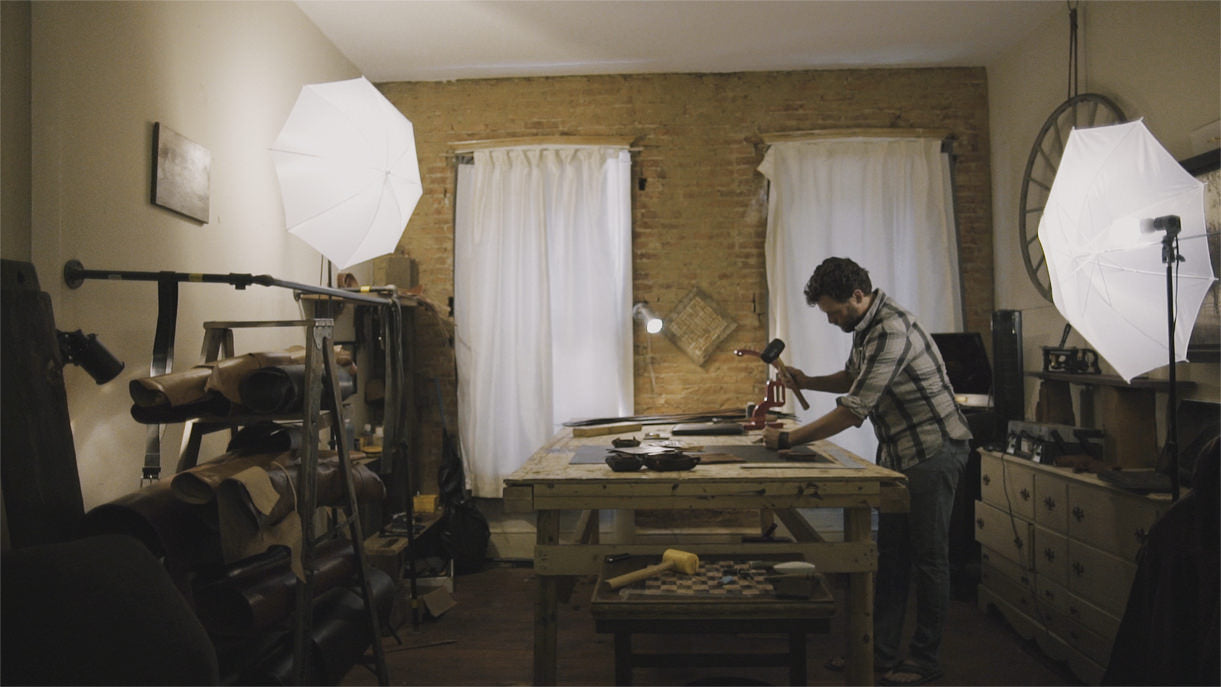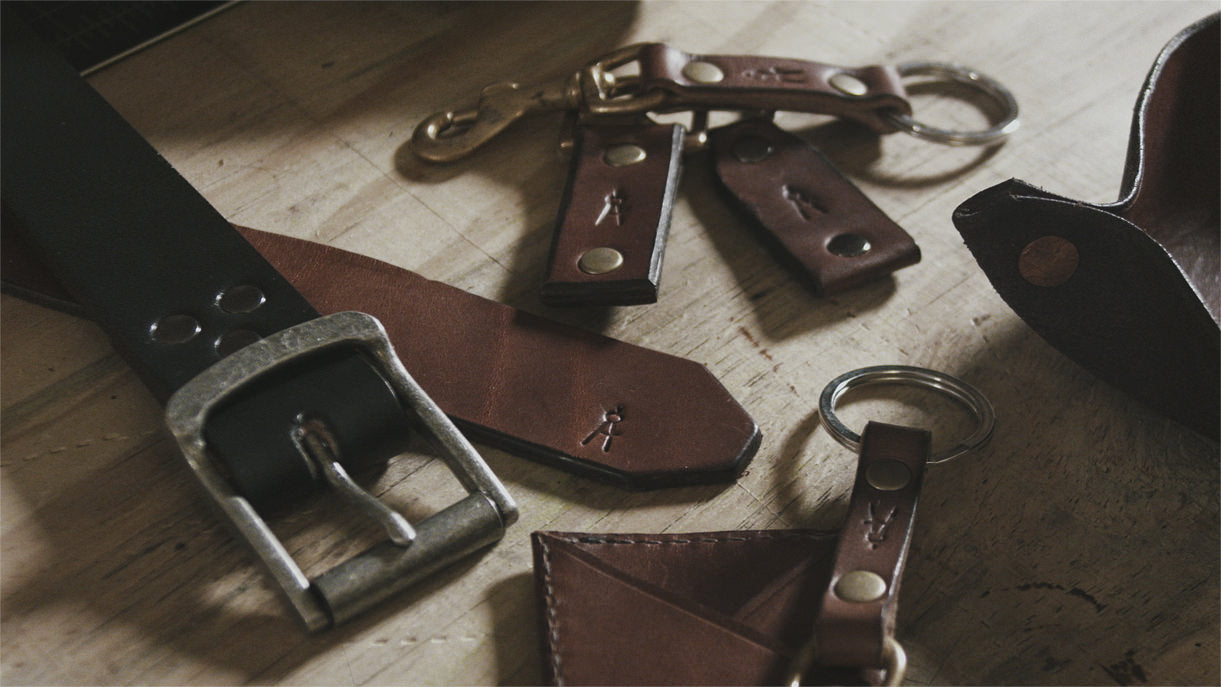When Michael Glick talks about what he does for a living, his brow furrows in serious concentration, and alternately brightens in moments of genuine enthusiasm. His steady voice articulates technical aspects of his process with poise, and breaks into a laugh that can only come from someone who is deeply passionate about what he does. Michael is a maker. He produces leather goods by hand, under the brand Black Bear Leather. He wasn’t always a leather maker, but having heard his story, we’re convinced its what he’ll be doing for years to come.

Michael was born in Lancaster County to Amish parents. Then he moved with his family to Farmville, Virginia where he spent most of his teenage years, going on to study politics at American University. After a few years working in Washington D.C., he moved back to Lancaster County to help run his family’s business, Black Bear Structures, from which he derived the Black Bear Leather brand. When he moved back to Lancaster County, Michael begun to discover the nearly forgotten tradition of leather working in the area, largely preserved by the Amish community’s need for carriage harnesses. Reaching back into the past (his great-great grandfather, and namesake, was a leather worker!) Michael has become entranced with this craft and has been pursuing it ever since.

Many of us use leather goods everyday, from belts to briefcases, wallets, purses, jackets, watchbands, boots and shoes, jewelry. You could go on and on. But have any of us ever stopped to wonder where the leather comes from? Given Michael’s passion, it is unsurprising that he’s somewhat of an expert on this too. There is so much to know about how a cattle hide becomes pristine rolls of raw material on the workshop shelf—waiting to be measured, cut, and pieced together with needle and thread—it has taken him years to acquire this knowledge through reading, experimenting, and visiting leather producing facilities in person.
Michael is committed to using only the highest quality, American made, vegetable-tanned leather, and he is supplied by one of the few places left in the country that tans hides the old fashioned way. This company, Wickett and Craig, is located in Curwensville, Pennsylvania and specializes in making leather exclusively through the traditional vegetable-tanning process. They use tannins collected from tree bark or other plant material and allow the hides to cure, soaking up these natural compounds over a several week process.

Michael’s workspace is located in a Lancaster city row home owned by his brother, from whom he rents the first floor. He and his brothers worked to expose aging brick along the length of one wall and tore out several layers of artificial, mid-20th century flooring to reveal a handsome, wide-board floor that is original to the building. The space is filled with slab-wood furniture and is lit with photographer’s lights that fill the room with crisp, clean light, all able to be controlled via an app on his phone. The lighting allows Michael to make precision cuts and make delicate alignments of thin pieces of leather that will be joined together with thread. Watching him move around his studio, his tools close at hand, his head lowered in studied focus, is like watching some workaday miracle of the natural world—a bird building a nest or a bee hovering diligently around a cluster of wildflowers—creatures doing the work that they were made to do. Michael enters a flow state that is, frankly, enviable. Watching him work, even briefly, it is apparent in his attention to detail and mastery over his material, that he has found a calling. He is living proof that humans can find deep meaning in the process of creating, crafting, making, as if this is exactly what we are all here for.
For each product, Michael must first determine what type of leather is right for that project. He almost always uses top-grain leather, which is the strongest and provides the most strikingly beautiful grain patterns. The thickness, of leather is measured in ounces. For sturdy projects like belts, where weight isn’t an issue, 12 oz leather is used. For bags or briefcases that need to be durable, but not too heavy, 8 oz leather does the trick. For the delicate construction of a men’s wallet, 2 oz leather keeps the many folds and layers thin enough to fit comfortably in your back pocket. The next major aesthetic consideration for Michael, outside of the product’s design, is the color of the leather. This typically ranges from an oaky, light brown, to dark chestnut brown, to mahogany brown, and rich black, and each batch has a slightly unique hue.
The most amazing aspect of Michael’s process is that he doesn’t do a lot of preplanning. He doesn’t systematize his process into something mechanistic. Instead he remains intuitively involved with the material and process, making every cut, every stitch, significant. As a result, no two of his products are exactly the same and each one has its own distinctive character.

The “maker movement” has been spreading across the states over the past several years. Many of us are hungry for locally made well-crafted goods that reflect our distinctive values, rather than the one-size fits all products that are mass manufactured in factories thousands of miles away. From craft beer, handmade furniture, local produce, and farm to table restaurants, it seems that the next generation of American consumers is casting its vote. We are willing to pay for quality, especially if it will support the passions of those around us. Michael seems optimistic that this movement will continue expanding from a fringe trend into a cultural norm. Why buy a product that will need to be replaced in a year, when there are products, like a handcrafted leather bag, you could pass down to your children someday?
Lancaster County’s tradition of quality, locally made goods is a unique part of the way we’ve operated since settlers first came to this area. Michael attributes this to the traditional methods of producing goods that have been preserved within the Amish and Mennonite communities. But he also thinks that the next generation is taking that traditional knowledge and making it new. He is tapping into the traditions and innovating. Our thriving mini-urban context provides Michael with the same sense of energy, excitement, and creative urban culture that he says he had living in Washington D.C. But to him, Lancaster also provides a better sense of belonging and an opportunity to connect with other people in the community.
As curators of uncommon goods, Ellicott & Co. strives to bring together local makers with a propensity for creating aesthetically pleasing, ruthlessly functional, high-quality American made products. By bringing makers like Michael together to celebrate our strong traditions of craftsmanship, we aim to support the makers themselves while providing curiously uncommon goods to the Lancaster community and beyond.




